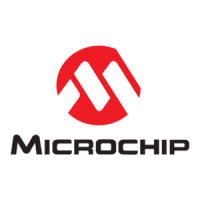16. Ethernet
Problem 42: An Ethernet connection cannot be established.
•
Be certain the network side of the magnetics face the RJ45 connector and the device side of the magnetics face
the LAN device.
• Differential pairs must be constructed as 100 Ohm, controlled impedance pairs.
• Differential pairs must be the same length.
• Distance between L an IC and magnetics must be ≤ 2.5 inches.
• Ensure that the PCB layout rules defined in the sections below are met.
16.1 Special Ethernet 10/100 Base-T Design Guidelines
16.1.1 Ethernet TX± and RX± Differential Pair Considerations
1. Both the RX± and TX± pairs must be routed as differential pairs. This includes the entire length of travel of the
traces from the RJ45 connector to the LAN device.
2. the RX± and TX± differential pairs should be routed as close together as possible. Typically, when beginning
the impedance calculation, the smallest trace space (4 – 5 mils) is selected. The trace width is then adjusted to
achieve the necessary 100 Ohm impedance.
3. Differential pairs should be constructed as 100 Ohm, controlled impedance pairs.
4. Designs employing common mode chokes for EMI isolation must be 100 Ohm.
5. Differential pairs should be routed away from all other traces. Try to keep all other high-speed traces at
least .300” away from the Ethernet front end.
6. Each trace of the differential pair should be matched in length. The matched lengths of each positive and
negative pair should be within 50 mils of each other.
7. The differential pairs should be as short in length as possible.
8. The use of vias is not recommended. If vias are used, keep to a minimum and always match vias so the
differential pairs are balanced.
9. Layer changes are also not recommended. Keep the differential pairs referenced to the same power/ground
plane whenever possible.
10. For optimum immunity, route Transmit pairs and Receive pairs as far away from each other as possible.
11. Always reference any Transmit terminations to the same reference plane that the Transmit routes are
referenced to. Likewise, always reference any Receive terminations to the same reference plane that the
Receive routes are referenced to.
12. Precedence should be given to the differential pair routing. Terminations must be added after the routing is
determined. The terminations should simply be “dropped” onto the differential routing.
13. All resistive terminations in the Ethernet front end should have values with 1.0% tolerances.
14. All capacitive terminations in the Ethernet front end should have tight tolerances and high-quality dielectrics
(NPO).
15. For optimum separation, experimentation can be explored with inserting a ground plane island between the
Transmit pair and the Receive pair. A separation from this ground plane from any of the traces of 3 – 5 times
the dielectric distance should be maintained.
16. This same technique can be used to separate different Ethernet ports if port cross talk is an issue. A ground
plane can be inserted between Ethernet channels. The separation space between the two channels must be
as wide as possible. Again, a separation from this ground plane from any of the traces of 3 to 5 times the
dielectric distance must be maintained.
16.1.2 Unused Ethernet Cable Pairs Considerations
1. The unused cable pairs (pins 4, 5, 7, and 8 on the RJ45 connector) must be properly terminated for common
mode considerations. These terminations must be routed with heavy
, short traces and as close as possible to
the RJ45 connector.
Ethernet
© 2022 Microchip T
echnology Inc.
and its subsidiaries
Manual
DS70005439B-page 61

